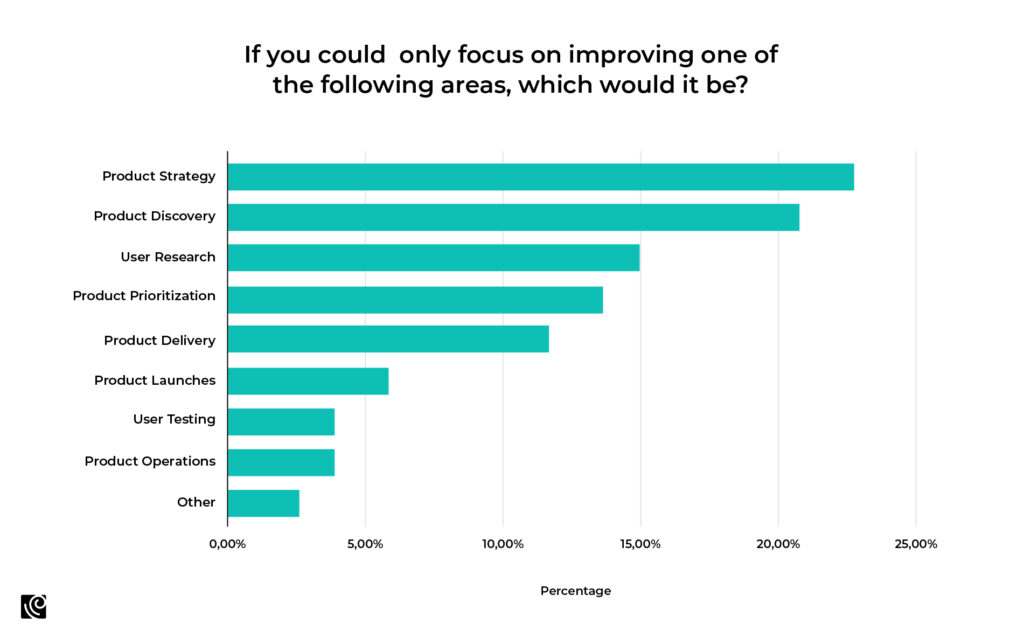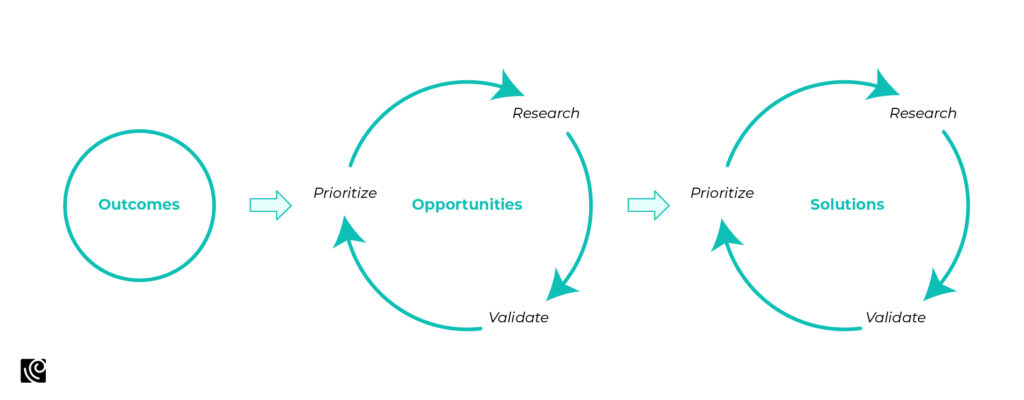Every transformative product begins with an informed product discovery phase.
Consider Slack. Before securing its foothold in the enterprise communication ecosystem, its development was rooted in exhaustive research on workplace communication pain points, refining its origin from its predecessor, Tiny Speck.
Dropbox’s trajectory wasn’t just about offering cloud storage. Their edge came from an incisive discovery process that highlighted a market gap: the need for a straightforward, intuitive user interface.
According to a McKinsey study, an unnamed company enhanced its face-to-face services with digital touchpoints, leading to a 5 to 7% boost in sales productivity. This strategic shift underscores the powerful outcomes of an effective product discovery process.
➝ In product leadership, true innovation is underpinned by efficient and thorough product discovery.
➝ As much as the passion for discovery is valuable, aligning it with market realities and specific user needs ensures tangible results.
In a Reveall survey with over 250 product teams, when posed with the question, “If you could hone in on only one area of improvement, what would it be?” – product discovery came in with a roaring second place.

This indicates both its undeniable significance and the collective challenge discovery presents. Hence, it’s not just about mastering discovery; it’s about mastering it efficiently. Dive into the five transformative product discovery techniques and watch your product leadership soar.
A Brief Prelude to Product Discovery
Product discovery is a process of defining the exact requirements of users through systematic research before building the product. It directly impacts the product’s success, user adoption, and ROI. Neglecting or hastily navigating this phase can result in:
- Misaligned products with costly re-dos
- Unnecessary resource expenditure
- Missed market opportunities

Teresa Torres’s concept of “continuous discovery” emphasizes its ongoing nature. It involves:
- Weekly interactions with customers
- Facilitated by the team responsible for the product
These interactions, coupled with consistent small-scale research endeavors, aim to achieve a specific product outcome. This approach ensures that B2B products stay aligned with user needs and market demands, positioning them for success and adaptability in a competitive landscape.
Before we delve into the transformative techniques, here’s an invaluable visual resource that impeccably outlines the entire workflow of a product leader’s or product manager’s feedback and discovery process:
Just ridiculously good.
— Carl Vellotti (@carlvellotti) September 6, 2023
Step-by-step flowchart of the product discovery process, with reading recommendations. By @aatirar. pic.twitter.com/J4aT32CvUE
Unpacking 5 Game-Changing Product Discovery Techniques
Product discovery is a vast ocean of techniques and strategies. While many teams find comfort in tried-and-true methods, the thirst for innovation is undeniable. Let’s dive into techniques that can truly revolutionize your approach.
Reverse Discovery: Backtracking to Find Unseen Opportunities
While the top-down method has its merits, it can sometimes be restrictive. It occasionally risks overlooking intricate details or bypassing latent opportunities that arise from already existing solutions.
*Enters reverse discovery.*
Think of it as a way to backtrack from a set destination (your product or feature idea) to understand the journey (discovery process) better. It capitalizes on the human instinct to hone in on details—taking established solutions and connecting them back to their root opportunities and desired outcomes.

Let’s take a look at a case study by Reveall’s experience with reverse discovery. When diving into their early discovery phases, they found themselves often gravitating immediately toward solutions.
Recognizing this instinct, their CPO, Marcel Hagedoorn, proposed ‘reverse discovery.’
Using their current backlog as a springboard, they mapped out existing product ideas, linking them back to their root opportunities. This method didn’t just breathe new life into old ideas; it also led to the conception of a novel onboarding flow.
New customers at Reveal were encouraged to reverse-engineer the discovery process using items from their backlog/roadmap. By seamlessly merging top-down and bottom-up strategies, Reveal optimized its ideation process, populating its opportunity tree more robustly.
Make Discovery Second Nature with Frameworks
You’ve probably been there: thinking about the “when” and “how” of discovery. But, too much fixation on these questions can slow down the entire product cycle.
The trick is to move beyond decision-making to operationalizing discovery.
It’s about making discovery an automated, simplified, and regular heartbeat of your process, so much so that it becomes a reflex, rather than a scheduled event.
Frameworks (like those popularized by Teresa Torres) can serve as powerful tools in this endeavor. These continuous discovery frameworks emphasize not the decision-making aspect but the operationalization of the discovery process itself.
“A lot of what Teresa teaches is about the mechanisms and getting the operational side automated and simplified and regular. Then you don’t even have to think ‘When are we going to do discovery’ because you’re always doing it.”
Emily Tate, product leader, managing director, and VP at Mind the Product
Operational efficiency is achieved when processes become instinctual. Think of innovative ways, like using a pop-up to source interview candidates which redirects to a Typeform. It’s these small automations that accumulate to make discovery an ever-present process.
Framework in Action: A Case Study
In a ProductTank Heidelberg talk, Konstantin Diener, CTO, and Co-founder at product design consultancy Cosee, shared his journey into continuous discovery. In 2020, they were faced with the challenge of transforming the board and card game trade fair, Spiel Digital, from an in-person to a digital event.
Leveraging Teresa Torres’ Opportunity Solution Tree, the team crafted a structured approach to align opportunities with solutions, reminiscent of U.S. railroad pioneers’ planning methodology.
Their approach birthed a virtual fair, drawing over 150,000 visitors!
Their methodical approach, rooted in goal-oriented milestones, ensured that by a specific time, every stakeholder had clarity on deliverables. Their community’s feedback provided them with direction and motivation, leading to a board-game-like user experience, setting benchmarks in interactive virtual exhibition spaces.
The Research-Discovery Nexus: A Symbiotic Pathway to Product Innovation
While both concepts are distinct in their own way, they are intimately connected. Michelle Lotia, head of user research at Trainline, points out that:
Research frames the key conversations essential for product decisions. On the other hand, discovery emerges from the outcomes of that very research. It’s not just about following steps in order, but making both seamlessly work together.
- Research dives deep into understanding user needs, shaping perspectives, and influencing prioritizations.
- Discovery revolves around applying these learnings and uncovering revelations even in the initial research phases.
This symbiosis between research and discovery provides clear direction, minimizing costly reworks and ensuring the product aligns with market needs right from inception. Consequently, the integrated approach translates into substantial savings, both in time and resources, and positions the product for optimum market reception.
How To Efficiently Use Research and Discovery to Influence Product Decisions
- Humanize Your Data with Storytelling: Data on its own might seem sterile. Embed your findings within compelling narratives to make them relatable, reducing apprehensions and ensuring better engagement.
- Know Your Stakeholders: Recognize that every key decision-maker has unique perspectives. Initiate conversations with each to understand their viewpoints and operational styles.
- Regular Updates: For expansive research projects, consistently update all participants to swiftly disseminate findings, ensuring everyone is on the same page.
- Go Beyond Just Findings: Recognize that some business decisions might be outside your control. However, by presenting research findings in a structured, impactful manner, it becomes possible to persuade stakeholders and drive desired actions.
Always Be Chatting: The Power of Continuous Interviews
Continuous interviewing is a cornerstone of modern product development. Teresa Torres underscores its significance, emphasizing a shift from a project-focused mindset to a continual one.
Interviewing should be continuous and generative, in order to collect customer stories and discover opportunities rather than solutions.
The aim?
- To gather customer narratives
- Pinpoint opportunities
- And steer away from prematurely narrowing in on solutions.
Teresa also proposes multiple automation solutions, like:
- Tapping into regular visitors
- Engaging customer-facing teams
- Crafting a customer advisory board
Make sure to ask the right questions. Having a good team structure helps with this. Instead of guessing, listen to customer stories. These stories can show you new chances to improve. Work on many ideas for one problem. The more team members help, the more varied the ideas. Make sure you do not stick to just one idea because it can make you biased. Instead, try out different solutions for one problem and pick the best one.
Next, you need to break these sets of solutions into underlying assumptions and rapidly test them. Ideas are based on the set of assumptions that things are desirable, viable, feasible, ethical, and usable.
“The more diverse your team is, the more likely it is you’ll catch your riskiest assumptions,” she adds, “This is definitely an area where you want the whole team involved.”
Teresa Torres, Product Discovery Coach
Stay Ahead with Competitor Analysis Sprints
Competitor Analysis Sprints are strategic sessions where teams allocate focused periods, often a week or less, to delve into understanding both direct and indirect competitors. The primary goal is to quickly identify unique features that competitors offer, spot gaps in their offerings, and pinpoint potential opportunities for differentiation or improvement.
Running these sprints offers multiple benefits:
- Dynamic Market Landscape: Markets evolve. What may seem like a competitor’s strength today can become a weakness tomorrow. Regular sprints ensure that you keep up with these changes.
- Iterative Learning: Instead of overwhelming your team with extensive research findings, sprints allow you to prioritize and act on the most pressing insights.
- Timely Re-calibration: Frequent checks give teams the opportunity to adjust their strategy, ensuring the product remains competitive.
- Spotting Trends: Regular analysis helps in recognizing patterns and trends in the market, which can offer valuable insights for future planning.
- Continuous Improvement: The iterative nature of sprints aligns with the ethos of continuous improvement, encouraging teams to enhance their products based on up-to-date competitor insights consistently.
- Risk Mitigation: By constantly understanding the market, teams can anticipate potential threats and adjust before significant issues arise.
Final Words
Efficiency in discovery isn’t just a strategy—it’s a game-changer. As the digital ecosystem evolves, product leaders can no longer afford to rely solely on traditional methods. Groundbreaking success stems from a harmonic blend of insight, precision, and timely innovation. The right techniques can elevate a mere idea to a standout product in a saturated market, positioning it a cut above the rest.
As emphasized, the focal point remains in not just discovering but doing so with acute efficiency. By adopting modern methods such as reverse discovery, operational frameworks, or competitor analysis sprints, you essentially amplify the very essence of efficiency.
However the benefits transcend the conceptual phase. These strategies aid in carving out products that resonate profoundly with the target audience, creating a ripple of engagement and setting a precedent in the industry. We implore product leaders to embrace these indispensable methods for efficient discovery. Start today, refine your discovery process, and witness your product transcend ordinary boundaries.









